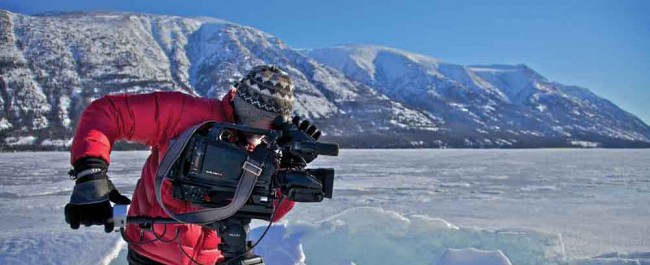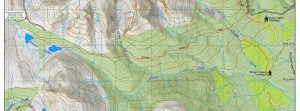
Photo Credit: Taylor Fox
Northern landscapes on the big screen: Local filmmakers raise awareness through imagery
In a place where our day-to-day lives are lived between a vast network of grand landscapes, it’s easy to appreciate the North’s natural environment. But what does it take to get the public fired up enough to be passionate about protecting its future? In some cases, the answer is a good script, strong science and powerful imagery.
People need only to turn to the web for evidence of the power of film. But even before the Internet gave us the ability to make a movie go “viral,” film was a catalyst for change.
Its ability to motivate, inspire and inform has not been lost on local people who care about the environment. In northern BC, movies are being made to keep the public informed about conservation efforts and highlight what could be at stake without them.
For Terrace-based SkeenaWild Conservation Trust, film has become a line of communication to the public.
The initiative takes a science-based approach to ensuring the future of the Skeena watershed’s wild salmon ecosystems. Informed by research, the organization works with First Nations and industry to promote sustainable fisheries and ensure industrial development is carried out safely.
Projects coordinator Julia Hill says SkeenaWild’s goal is to create a global model of sustainability.
“The Skeena watershed is truly one of the last opportunities, we believe, in the world where we can manage resources differently,” she says. “There are relatively large human populations living alongside a relatively wild salmon ecosystem and that is unique.”
Communicating science
Established in 2007, SkeenaWild began as a fisheries management organization. As the trust matured, it became apparent that more community engagement was needed. The group wanted to keep the public informed about its scientific work, while sparking the interest of potential supporters.
However, it wasn’t easy to present information about complex topics, such as research into the impacts of mining toxicity on salmon, in an interesting and palatable format. Sending out the findings of a report wouldn’t do the job. Hill says the organization had to learn how to communicate in a more understandable and compelling way.
“Most people aren’t going to read a scientific report, but it’s important information, so how are we going to share this information?” Hill says. “We decided that film is the absolute best way to do it, so we started doing info-graphic animation videos to help make high-level scientific information digestible for the average person.”
Film has since become a major part of the organization’s relationship with the public. Hill says SkeenaWild’s videos, made by in-house filmmaker Rod Brown, are intended to provide factual information to help people form an opinion.
“Our scientific credibility is our greatest asset and that’s a very important thing for SkeenaWild,” she says. “Our goal is to communicate that, because it’s the job of citizens living in our region to take decision-making back.”
In addition to making its own videos, the trust runs an annual festival of films and photographs submitted by the public. Hill says the goal is to showcase a cross-section of perspectives with a focus on community, connection to place and outdoor adventure.
She says the entries are chosen by a panel of community members and not by SkeenaWild staff. Although the subject matter is not dictated by the trust, there are tangible benefits for the organization.
Hill gives the example of a man who changed his position on a development after one of the documentaries raised concerns about it. He contacted SkeenaWild to show his support and offered to volunteer.
“I would say in any given year we get about five to 10 letters from people with reactions similar to that,” she says. “I think that’s what film can offer … new perspectives and fresh perspectives and that is a really a great way to engage our communities in a dialogue about our future.”
Catalyst for change
The desire to ignite people’s passion about the planet’s future is shared by Smithers-based filmmaker Monty Bassett. His company, Out Yonder Productions, has made films for the Discovery and National Geographic channels and is currently filming the last in a four-part series for the Oasis channel.
As his company motto states, Bassett makes films that show “our planet, through a sympathetic lens.”
Driven by scientific curiosity and a passion for the natural world, Bassett makes nature documentaries that showcase the region’s grand beauty and highlight the potential threats and social impacts of industrial development.
He became a filmmaker after his first documentary, the one that cemented his future in the industry, alerted him to the power of film as a catalyst for change.
In the 1980s, Bassett learned of plans to carry out clear-cut logging of slow-growing boreal forests in the province’s northwest and felt compelled to stop it. When a friend suggested making a film to highlight the project’s impacts, he adopted the idea and hired cinematographer Myron Kozak to start filming in the area.
Tragically, Kozak was killed in a light plane crash partway through the project, leaving Bassett shocked and unsure how to proceed. He called the Vancouver studio where Kozak had stored the footage and one of the editors offered to help him script and edit a short film.
The result was Cassiar at the Crossroads, a 20-minute video narrated by high-profile environmentalist David Suzuki. Bassett says public reaction to the film was explosive and the logging was stopped.
“Suddenly, I realized the power of film in touching people and it’s only gotten stronger,” he says. “The more we move away from books and normal sources of information, we are getting deeper and deeper into motion visuals.”
The success of Cassiar at the Crossroads launched a career that allowed him to continue making documentaries that, he hopes, inspire viewers to take an interest in the natural world.
“To influence people, to expose people, to get people thinking—film is the way to do it, short of taking them into the wilderness,” he says. “Consequently, everything that we’ve done has not only the component of original science, but we try to raise awareness of what there is around us.”
Bassett believes people feel helpless because environmental problems are so immense and solutions, such as electric cars, are not easily accessible. Through his next project, a series about people who stood up to corporations and won, he hopes to empower his audience.
“I think by now we all get the message about climate change and our influence upon the planet, but we all say, ‘yeah but what can I as one person do?’” he says. “This 13-part series is going to profile groups and individuals around the world who have been powerless and stood up to the biggest corporations, the biggest tyrants, and said ‘no, you are not going to do that.’ Then you give people hope.
“We all need role models and here are role models, people who have done something to change the direction.”
Luckily for Bassett, and other local filmmakers with a passion for their planet, northern BC has no shortage of hard-to-ignore landscapes and powerful stories to help them make a lasting impression on their viewers.





